

What is lead scoring?
Lead scoring is the process of assigning a “score” to each one of your contacts that reflects their conversion potential and level of interest in your business. This score can be used to qualify leads for marketing messages or sales outreach.
A targeted message sent at exactly the right moment is often all it takes to convert a lead into a paying customer. But how can you figure out when the lead will be most receptive to your offer?
With a lead scoring model that helps you identify the people who’ve shown the most interest in your product or service.
So how do you set one up? It’s actually quite easy when you’re using a marketing automation platform like Sendinblue.
Follow along and we’ll teach you how to:
- Map out your buyer journey and assign scores based on actions and events
- Set up a marketing automation workflow in Sendinblue that assigns points to actions taken by a lead
- Dynamically segment your lists with lead scoring
But first, let’s look at how your business can benefit from a lead-scoring model.
Why you need a lead-scoring model
As marketing tools become more sophisticated, consumers will continue to develop less tolerance for marketing that isn’t personalized.
Nobody likes to feel like they’re being sold something. It’s uncomfortable and can sometimes even feel invasive, especially if you’re not looking to make a purchase at that exact moment.
This is what often happens when businesses don’t take the time to nurture or guide leads through the acquisition life cycle.
Many businesses, particularly those in the B2B industry, require a large amount of trust and education before they can convince leads to make a purchase. That’s why it’s so essential to track leads as they move closer to a conversion, adjusting your marketing tactics and messaging along the way.
Lead scoring works particularly well with email marketing. Here’s a video explaining the concept:
Create a lead scoring model with marketing automation

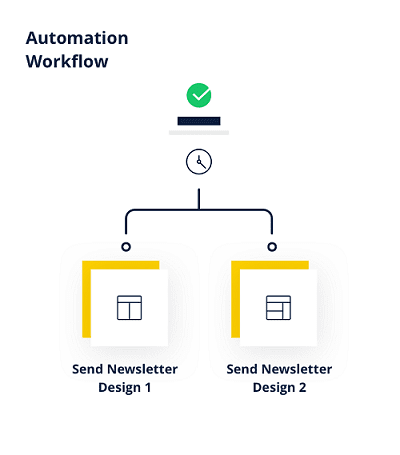
The easiest way to do this is to implement a lead scoring workflow with marketing automation.
You get it. Marketing automation is one of the most powerful tools in your marketing toolbox.
You’re probably already aware that automation allows you to send automated emails (welcome messages, abandoned cart follow-ups, etc.) at the perfect time to your customers and combine these with other conditions and filters for more personalized communications.
But did you know you can do much more? Businesses that use marketing automation to speed up their sales funnel see a 451% rise in qualified leads.
If you’re not getting that kind of boost in leads from your marketing automation, maybe it’s time to step it up a gear.
You can use Sendinblue’s Marketing Automation to build a powerful lead scoring or loyalty scoring system while saving yourself hours of time.
Loyalty scoring works the same way as lead scoring but with existing customers. Use customers’ actions on your platform and purchase histories to automatically generate a loyalty score for them. You can use this score to determine who to invite to exclusive loyalty programs that will encourage upsells and brand advocacy.
Example of Basic Lead Scoring Automation


In this basic lead scoring example, a contact opens your welcome email, clicks on a link and ten points is added to their score.
The logic is that a contact who clicks on this link in your welcome email clearly has a higher interest level in your business than a contact who fails to make the same click.
Obviously, this is a simple example and would be just a small piece of a larger lead scoring model, but hopefully, it illustrates the idea.
How to build a lead scoring model

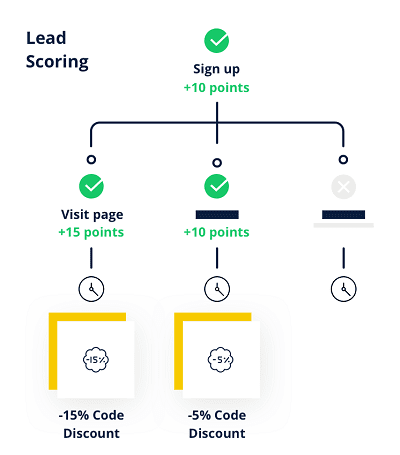
As previously mentioned, lead scoring helps automated lead scoring gives each of your marketing leads a numeric score. The score corresponds to a lead scoring model that you create, taking into account various details about your contacts, which may include:
- Contact attributes (e.g. demographic information)
- How they came to your site
- Specific behavior/actions (engagement with your emails, visits to specific pages on your site, etc.)
This helps you sort through all of the leads who come to your website and identify those who are most engaged and ready to convert.
So, how exactly do you go about setting a lead scoring model up?
Define the important steps leads take before acquisition
The first step is mapping out your acquisition life cycle. This usually consists of 4 stages:
- Awareness
- Engagement
- Exploration
- Acquisition/Retention
For lead scoring, you should really focus on the first three stages.
To create your lead scoring model, you will need to identify key actions that leads take and categorize them according to each of these stages. Then you can determine the proper amount of points to assign each action for your lead scoring automation workflow.
Awareness
Awareness is the very top of the acquisition funnel. It consists of the very first actions users take when they visit your site.
In the case of lead scoring for known contacts, this is usually indicated by signing up for your email list. You could also include people who give you their email address from an event or for a contest.
For the actions that fall into this first step, you can assign them a relatively small number of points (e.g. 5 or 10) to get them started in your lead scoring model.
Important: If you have contacts living in Europe, make sure your email signup forms are GDPR-compliant. Clearly state that you plan to send targeted emails using marketing automation according to their behavior and interests.
Engagement
In this stage, contacts have moved beyond the point of just being aware of your business to actually engaging and showing real interest. Actions at this stage might include:
- Downloading an eBook or other resources from your site
- Frequently engaging with your email campaigns or newsletter (e.g. clicked on your 3 previous emails)
Actions in this stage should receive more points than the previous (e.g. 10 or 20) because they show a higher level of interest in your business.
Exploration
This is the final stage before conversion. It is usually the point at which leads have realized they need a solution and are researching their options. Exploration actions would probably include:
- Contacting sales
- Filling out a form for a quote
- Visiting your pricing page
These actions will receive the highest amount of points (e.g. 30+) and should push your contact into the category of “sales qualified leads.”
How to set up lead scoring with Sendinblue
You’ve identified the key actions your contacts take before becoming customers. Now it’s time to put your lead scoring model into action with Sendinblue.
Don’t have a Sendinblue account yet? Sign up for free and test-drive the Marketing Automation feature. Our free plan lets you set automation workflows for up to 2000 contacts.
The steps below will show you how to set up a lead scoring model with Sendinblue. Alternatively, you can watch this video:
Assign points to actions in marketing automation workflows
If you’re a Sendinblue user, start by creating a ‘SCORE’ contact attribute.

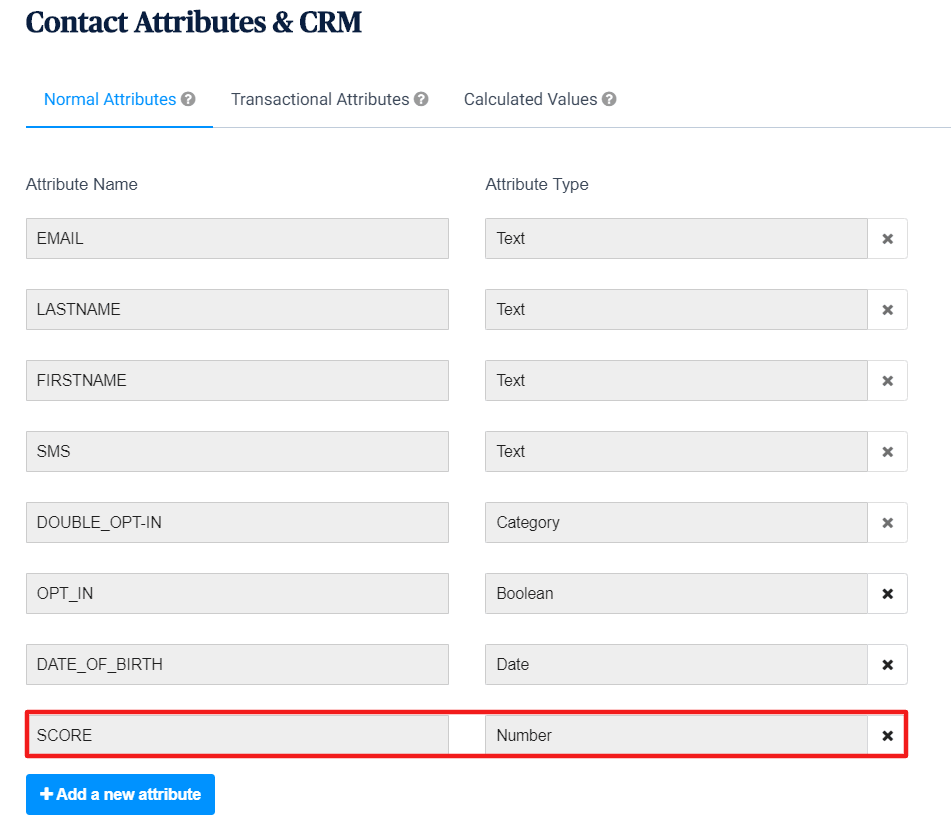
Once that’s done, you need to determine which actions update a contact’s score and by how many points.
Start by creating workflows for each of the three stages in the acquisition cycle.
In each of these workflows, create starting points that correspond to each of your key actions in this stage. If you want this action to update the lead score, add a step to the workflow at that point and select ‘Update contact attribute‘.

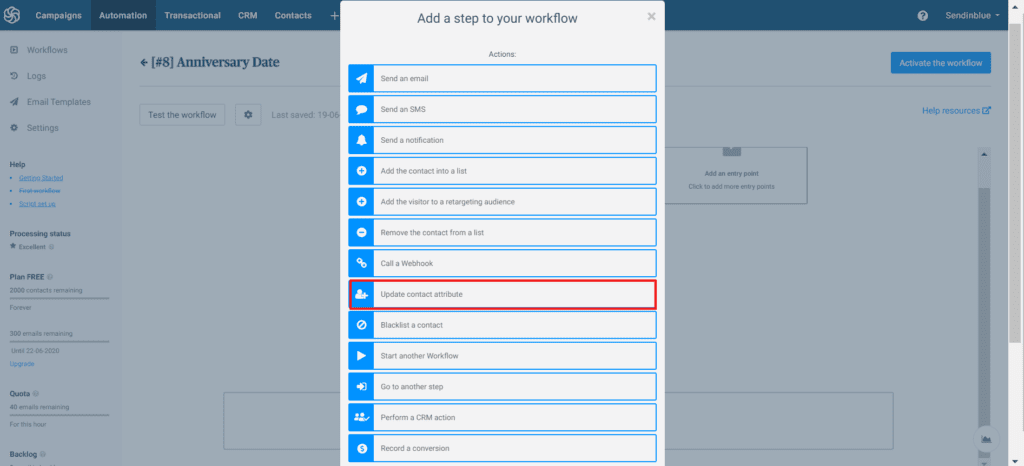
Select the ‘SCORE’ attribute previously created and define the number of points by which the score should be updating following this action.

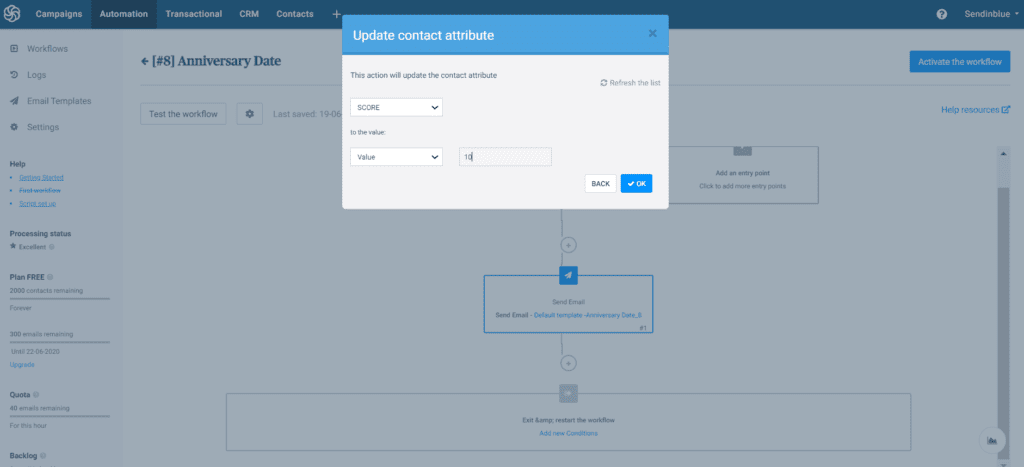
If you follow this method, make sure to check the box that allows contacts to enter the workflow multiple times.
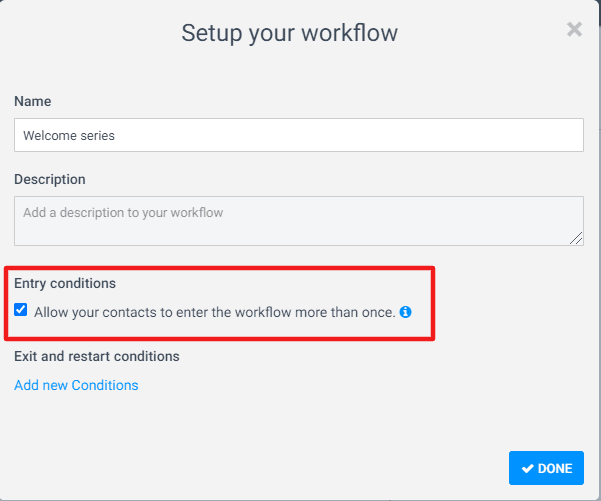

This will ensure that they receive points for any of the key actions in this category.
Dynamic list segmentation with lead scoring
Dynamic segmentation consists of using marketing automation to arrange contacts into specific lists based on specific characteristics or behaviors to better target them with your marketing emails in real-time.
Although you can create dynamic segmentation using various methods (specific action triggers, contact attributes, etc.), it is also one of the most popular use cases for lead scoring.
Once you create your lead scoring model, you can use each contact’s score attribute to determine which list they should be added to. This will enable you to send email campaigns that are much more relevant to the reader.
Example:

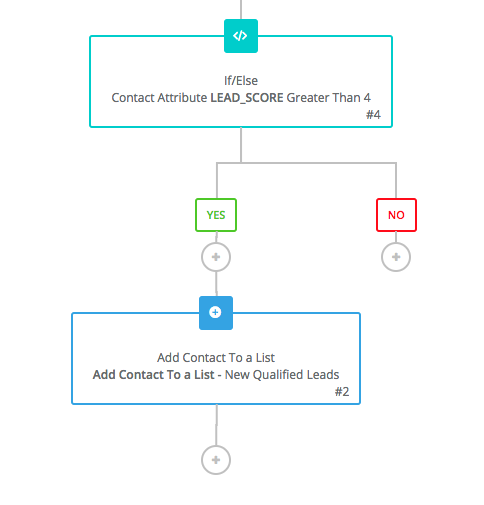
In the above example, when a contact reaches a score that is greater than 4, they will be added to a list of “new qualified leads.”
Create targeted contact lists
As we’ve just mentioned, you can use the lead score attribute to automatically add your contacts to targeted lists according to their interest level in your product or service.
To do this, simply assign point values to different categories of leads. Here is an example:
- New leads: Scores < 20
- Warm leads: Scores of 20 – 49
- Qualified leads: Scores 50 – 80
- Sales qualified leads: Scores > 80
After defining these parameters, you can set up your segmentation workflow to add users to each corresponding list.
Be sure to include an “escape” that resets your leads score if they start to show a lack of interest after receiving more targeted emails from you. You can use a condition based on their engagement with email campaigns in a set period of time (e.g. the previous 30 days).
Note: If some of your actions are highly qualified (e.g. requesting a quote from your sales team), you can include a condition in your lead scoring model workflow that automatically adds them to your “sales qualified leads” list.
Other use cases for lead scoring
Although we mostly talked about using lead scoring for dynamic segmentation, it can also be used for other purposes:
- Instead of segmentation, you can use lead score as a trigger to immediately (or after a set period of time) send that contact a specific email or SMS.
- Set up a score that is specific to one action (e.g. newsletter clicks) that is important to your goals and track engagement for specific contacts.
- Find your most qualified leads to use for ad targeting on platforms like Facebook and Twitter.
Check out this case study to learn about one of our partners’ experiences using email sequencing for lead generation with Sendinblue.
Check out this case study to learn about one of our partners’ experiences using email sequencing for lead generation with Sendinblue.
Boost conversions with lead scoring
Hopefully, this guide gave you a better idea of how you can use a lead scoring model to better target your leads. You should use these tips as a starting point and adapt the workflows to match your business goals.
Just make sure that whenever you implement this type of data processing, always obtain your subscriber’s consent. One of best ways to track proof of consent is by using double opt-in.
For more content like this, subscribe to our newsletter and follow us on Twitter.
 Deutsch
Deutsch




















